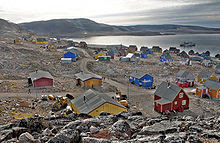++IN+THE+BACKGROUND+THE+SERMITSESQ+MOUNTAIN..jpg) |
| NUUK (GODTHEB) WITH SERMITSISQ MOUNTAIN |
Apart from Australia, Greenland is the large island in the world. Apparently it has a 2,175,500 sq km area but only a population of 57,000 inhabitants. It is mostly covered with ice and snow.
It belongs to Denmark but has its own
govern. It is 50 times the size of Denmark and the people live in the
rugged coastal areas. The coastal areas are free from ice and snow for
some time during the year. During the summer huge glaciers reach the
coast and when the glaciers brake apart they flowed into the sea. The ice
can reach a thickness of 1500m and it rises to a dome in the
centre. Greenland lies mostly inside the Arctic Circle. It
has, therefore, a polar climate and the temperatures are between -23oC in
February to 7oC in July in the south.
It is amazing how the animals have
adapted to these weather conditions. The polar bears living in the north-east
of the country and so do the ermine, lemmings. Arctic foxes and hares live more
towards the coast. Reindeer were introduced in 1953 from Norway. The trees
hardly grown more the two metres high in Greenland. The rest of the area is
heath-like, shrubby and impossible to grow any food there at all. However,
there are some sheep farms in the coastal area. The main industry is fishing
either for food for them or export. Shrimps, prawns and cod are netted off the
coast of Greenland and are exported. A limited number of whales are caught and
strictly recorded. For thousand of years the Inuit have caught the harp seal.
It provided food and clothing.
Mining of rubies began in 2007. There
are also other mining industries which are uranium, aluminium, nickel,
platinum, tungsten, titanium and copper.
The population in Greenland are
mostly Inuit (Eskimo). Research established that they came originally from
North America. Even so many people still live in the traditional way with the
elements but a large number moved into towns and worked there in fish
processing plants.
 |
| INUIT FAMILY IN GREENLAND IN 1917 |
 |
| NORSE RUINS THE LAST WRITTEN RECORD OF THE NORSE GREENLAND IS ON A MARRIAGE IN 1408 IN THE CHURCH OF HVALSEY. THIS IS THE BEST PRESERVED RUIN OF NORSE RUINS OF GREENLAND. |
HISTORY
Several successive Paleo-Eskimo
cultures were living there in the prehistoric times. It was established
purely through archaeological findings. It is assumed that the earliest
Inuit settlements were around 2500 BC. Between 2500 to 800 BC the Saqqaq
culture settled in southern and western Greenland and mostly around Disko Bay
according to the archaeological findings.
From 2400 BC to 1300 BC an Independent
culture lived in north Greenland. Around 800 BC the Saqqaq disappeared
and the early Dorset culture started to live in the western part of
Greenland. Then they spread throughout the Greenland coastal area.
They lasted till the arrival of the Thule culture that existed till 1500 AD. This
culture lived mainly from whale hunting and is the ancestor of today's
Greenlander.
Over a thousand years ago a Viking
Eric the Red re-discovered the land which was spotted by earlier voyages. He
called it Greenland. The reason for Eric calling this land Greenland was that
he thought people would be more tempted to colonize it if it had a nice name.
500 Icelanders sailed and
established two colonies. However, by 15th century the weather worsened. Then
they had to fight the Inuits and this resulted that the Viking
colonies died out.
In 1721 a Norwegian settlement was established
on the same site of today's capital, Godtheb (Nuuk).
In 1814 Sweden conquered Norway and
Denmark kept Greenland.
During the Second World War the US
protected Greenland and in 1953 Greenland became part of Denmark.
In 1979 the Greenlanders managed to
receive home rule and they named their country Kalatdlit-Nunat.
Scientist drilled two km through
Greenland glacier to recover the oldest DNA on record. They found that
the planet was far warmer hundreds of thousands of years ago than generally
believed.
DNA of tress, plants, insects plus
butterflies and spiders from the southern Greenland glacier was roughly dated
450,000 to 900,000 years ago. It is in great contrast to the previously
believe that a lush forest could not have existed in Greenland any later than
2.4 million years ago. The DNA proved the summer temperature reached 10oC
and the winter -17oC.
They also proved that in the last
interglacial period 130,000 to 116,000 years ago, temperatures were on average
5oC higher than now. The Glacier of Greenland did not melt away.
 |
| NANORTALIK |
 |
| THE COLOURFUL HOUSES TOWN ITT OQQORTOORMIIT |
SUMMARY:
Greenland is so fascinating
because it is completely different to most of other countries. It has a very
interesting history especially since the scientific discoveries. A wonderful
wildlife not to be found in many other places and the lives of the Intuits
are so interesting even so the climate is cold.
Hello, hello, my friend Hh - good to see your articles back online!
ReplyDeleteThank you for your lovely comment and welcome. I hope everything is all right with you? Nice to hear from you again. Take care and thank you again.
ReplyDelete